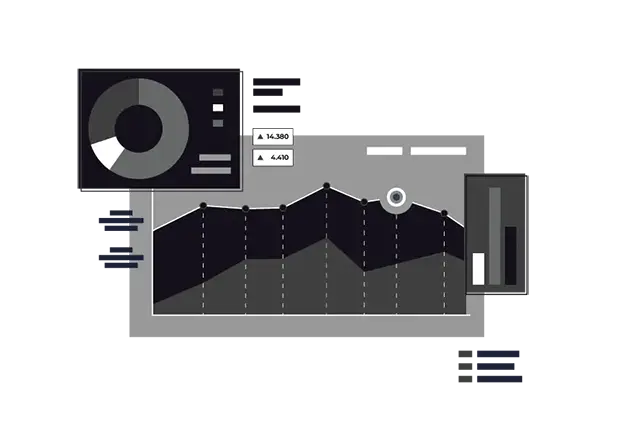

R (RStudio)
R is an open-source programming language and environment widely used for statistical computing, data analysis, and graphical representation. Coupled with RStudio, an integrated development environment (IDE) for R, it has become one of the most popular tools among statisticians, data scientists, and researchers. Developed initially by Ross Ihaka and Robert Gentleman in the early 1990s, R has grown significantly due to its open-source nature and the extensive community of developers contributing to its vast ecosystem of packages. R and RStudio provide a robust platform for performing complex data analysis, creating visualizations, and developing statistical models.
R (RStudio)
R is an open-source programming language and environment widely used for statistical computing, data analysis, and graphical representation. Coupled with RStudio, an integrated development environment (IDE) for R, it has become one of the most popular tools among statisticians, data scientists, and researchers. Developed initially by Ross Ihaka and Robert Gentleman in the early 1990s, R has grown significantly due to its open-source nature and the extensive community of developers contributing to its vast ecosystem of packages. R and RStudio provide a robust platform for performing complex data analysis, creating visualizations, and developing statistical models.
Mission and Vision
R's mission is to provide a powerful yet accessible environment for statistical computing and graphics. It aims to make statistical methods available to a broad audience of users, from novice data analysts to experienced researchers. RStudio enhances this mission by offering a user-friendly interface that integrates coding, debugging, and data visualization capabilities.
The vision of R and RStudio is to democratize data science by providing accessible, flexible, and reproducible tools for data analysis. Through continuous innovation and community-driven development, R seeks to empower users to make data-driven decisions, advance scientific research, and solve complex problems across various domains.
Key Features and Capabilities
R is known for its comprehensive suite of features that support data analysis, visualization, and statistical modeling. Some of its key features include:
 Comprehensive Statistical Analysis: R provides an extensive range of statistical and mathematical techniques, including linear and nonlinear modeling, time-series analysis, clustering, classification, and more. Its statistical capabilities are enhanced by thousands of user-contributed packages available on CRAN (Comprehensive R Archive Network).
Comprehensive Statistical Analysis: R provides an extensive range of statistical and mathematical techniques, including linear and nonlinear modeling, time-series analysis, clustering, classification, and more. Its statistical capabilities are enhanced by thousands of user-contributed packages available on CRAN (Comprehensive R Archive Network). Data Visualization: R's powerful visualization capabilities allow users to create high-quality plots, graphs, and charts. With libraries like ggplot2, users can produce complex, customizable visualizations that help communicate data insights effectively. R supports both static and interactive graphics, making it ideal for exploratory data analysis and reporting.
Data Visualization: R's powerful visualization capabilities allow users to create high-quality plots, graphs, and charts. With libraries like ggplot2, users can produce complex, customizable visualizations that help communicate data insights effectively. R supports both static and interactive graphics, making it ideal for exploratory data analysis and reporting. Reproducible Research with RMarkdown: RStudio integrates RMarkdown, which enables users to combine code, data, and narrative in a single document. This feature facilitates reproducible research, allowing researchers to generate reports, presentations, and dashboards that dynamically update with new data inputs.
Reproducible Research with RMarkdown: RStudio integrates RMarkdown, which enables users to combine code, data, and narrative in a single document. This feature facilitates reproducible research, allowing researchers to generate reports, presentations, and dashboards that dynamically update with new data inputs. Extensible through Packages: R's functionality can be extended with packages, which are collections of functions, data, and compiled code that enhance R's base capabilities. Popular packages include dplyr for data manipulation, tidyr for data tidying, and shiny for building interactive web applications directly from R.
Extensible through Packages: R's functionality can be extended with packages, which are collections of functions, data, and compiled code that enhance R's base capabilities. Popular packages include dplyr for data manipulation, tidyr for data tidying, and shiny for building interactive web applications directly from R. Integration with Other Languages and Tools: R can be integrated with other programming languages, including Python, C++, and Java, as well as tools like SQL and Hadoop, enabling complex workflows that combine data from multiple sources. This interoperability makes R a valuable tool for data integration and advanced analytics.
Integration with Other Languages and Tools: R can be integrated with other programming languages, including Python, C++, and Java, as well as tools like SQL and Hadoop, enabling complex workflows that combine data from multiple sources. This interoperability makes R a valuable tool for data integration and advanced analytics. Statistical Modeling and Machine Learning: R provides tools for developing and testing statistical models, including linear regression, decision trees, and random forests. With packages like caret and xgboost, R supports a wide range of machine learning algorithms, allowing users to build predictive models and assess their performance.
Statistical Modeling and Machine Learning: R provides tools for developing and testing statistical models, including linear regression, decision trees, and random forests. With packages like caret and xgboost, R supports a wide range of machine learning algorithms, allowing users to build predictive models and assess their performance. Data Wrangling and Manipulation: R offers powerful tools for cleaning, transforming, and managing data. The tidyverse package collection, which includes dplyr, tidyr, and readr, provides a consistent and easy-to-use syntax for data wrangling tasks, making it easier for users to prepare data for analysis.
Data Wrangling and Manipulation: R offers powerful tools for cleaning, transforming, and managing data. The tidyverse package collection, which includes dplyr, tidyr, and readr, provides a consistent and easy-to-use syntax for data wrangling tasks, making it easier for users to prepare data for analysis. Interactive Dashboards and Web Applications: With Shiny, R users can create interactive web applications that allow others to explore data and models in a user-friendly way. Shiny apps are widely used for data dashboards, teaching tools, and business intelligence, providing an interactive layer that enhances data communication.
Interactive Dashboards and Web Applications: With Shiny, R users can create interactive web applications that allow others to explore data and models in a user-friendly way. Shiny apps are widely used for data dashboards, teaching tools, and business intelligence, providing an interactive layer that enhances data communication. Extensive Community and Support: R's active community is one of its greatest strengths. With numerous forums, user groups, and online resources, R users can access a wealth of knowledge, tutorials, and shared code. The community-driven nature of R ensures that new methods and technologies are rapidly integrated into the ecosystem.
Extensive Community and Support: R's active community is one of its greatest strengths. With numerous forums, user groups, and online resources, R users can access a wealth of knowledge, tutorials, and shared code. The community-driven nature of R ensures that new methods and technologies are rapidly integrated into the ecosystem.
Applications and Use Cases
R is used in a wide variety of fields, from academia and research to industry and government. Key applications include:
 Data Science and Analytics: R is a primary tool for data scientists, offering comprehensive capabilities for data manipulation, analysis, and visualization. Its flexibility makes it suitable for exploratory data analysis, hypothesis testing, and predictive modeling.
Data Science and Analytics: R is a primary tool for data scientists, offering comprehensive capabilities for data manipulation, analysis, and visualization. Its flexibility makes it suitable for exploratory data analysis, hypothesis testing, and predictive modeling. Finance and Economics: R is widely used in financial analysis for risk assessment, portfolio management, and econometric modeling. Its statistical tools are ideal for analyzing market trends, simulating financial scenarios, and building forecasting models.
Finance and Economics: R is widely used in financial analysis for risk assessment, portfolio management, and econometric modeling. Its statistical tools are ideal for analyzing market trends, simulating financial scenarios, and building forecasting models. Biostatistics and Epidemiology: In healthcare and life sciences, R is used for clinical trial analysis, bioinformatics, and epidemiological studies. Its capabilities in statistical modeling and data visualization support the analysis of complex biological data and public health trends.
Biostatistics and Epidemiology: In healthcare and life sciences, R is used for clinical trial analysis, bioinformatics, and epidemiological studies. Its capabilities in statistical modeling and data visualization support the analysis of complex biological data and public health trends. Social Science Research: R's robust statistical functions make it a valuable tool in social sciences for survey analysis, demographic studies, and behavioral research. Researchers use R to analyze survey data, model social phenomena, and visualize results.
Social Science Research: R's robust statistical functions make it a valuable tool in social sciences for survey analysis, demographic studies, and behavioral research. Researchers use R to analyze survey data, model social phenomena, and visualize results. Marketing and Consumer Analytics: Businesses use R for customer segmentation, sentiment analysis, and predictive analytics. R's ability to handle large datasets and build complex models makes it a powerful tool for understanding consumer behavior and optimizing marketing strategies.
Marketing and Consumer Analytics: Businesses use R for customer segmentation, sentiment analysis, and predictive analytics. R's ability to handle large datasets and build complex models makes it a powerful tool for understanding consumer behavior and optimizing marketing strategies. Academic Teaching and Research: R is extensively used in academic settings to teach statistical methods, data analysis, and programming. Its open-source nature makes it accessible to students and educators, providing a hands-on platform for learning and experimentation.
Academic Teaching and Research: R is extensively used in academic settings to teach statistical methods, data analysis, and programming. Its open-source nature makes it accessible to students and educators, providing a hands-on platform for learning and experimentation.
Benefits of Using R and RStudio
R and RStudio offer numerous benefits that make them essential tools for data analysis and research:
 Open Source and Free: R is an open-source language, meaning it is free to use, modify, and distribute. This accessibility has led to widespread adoption and a vibrant community of users and contributors.
Open Source and Free: R is an open-source language, meaning it is free to use, modify, and distribute. This accessibility has led to widespread adoption and a vibrant community of users and contributors. Versatile and Flexible: R's extensive library of packages and functions allows users to perform a wide range of tasks, from simple data manipulation to complex statistical modeling and machine learning.
Versatile and Flexible: R's extensive library of packages and functions allows users to perform a wide range of tasks, from simple data manipulation to complex statistical modeling and machine learning. High-Quality Visualizations: R's data visualization capabilities are among the best available, enabling users to create detailed, aesthetically pleasing graphics that effectively communicate data insights.
High-Quality Visualizations: R's data visualization capabilities are among the best available, enabling users to create detailed, aesthetically pleasing graphics that effectively communicate data insights. Reproducible Analysis: R's support for reproducible research, through tools like RMarkdown, ensures that analyses are transparent, replicable, and easily updated with new data.
Reproducible Analysis: R's support for reproducible research, through tools like RMarkdown, ensures that analyses are transparent, replicable, and easily updated with new data. Community Support and Resources: The R community offers vast resources, including tutorials, documentation, and user-contributed code. This support network makes it easier for users to learn and stay updated with the latest developments.
Community Support and Resources: The R community offers vast resources, including tutorials, documentation, and user-contributed code. This support network makes it easier for users to learn and stay updated with the latest developments. Cross-Platform Compatibility: R runs on Windows, macOS, and Linux, making it accessible across different operating systems. Its ability to integrate with other tools and languages further enhances its flexibility.
Cross-Platform Compatibility: R runs on Windows, macOS, and Linux, making it accessible across different operating systems. Its ability to integrate with other tools and languages further enhances its flexibility. Scalable and Performant: R is capable of handling large datasets and performing high-performance computations, especially when combined with packages that optimize code execution or parallel processing.
Scalable and Performant: R is capable of handling large datasets and performing high-performance computations, especially when combined with packages that optimize code execution or parallel processing.
Promoting Collaboration and Knowledge Sharing
R and RStudio promote a collaborative approach to data science. Through platforms like RStudio Connect, users can share analyses, dashboards, and reports with colleagues and stakeholders, facilitating data-driven decision-making across organizations. The open-source nature of R encourages knowledge sharing, as users can contribute to and benefit from a vast array of community-developed packages and tools.
Impact on Research, Industry, and Education
R's impact on research, industry, and education is profound. It has become a cornerstone of statistical computing and data science, enabling researchers to explore complex data, businesses to optimize their strategies, and students to learn essential analytical skills.
 Advancing Research: R has played a crucial role in numerous scientific advancements, providing researchers with powerful tools for statistical analysis and data visualization. Its reproducibility features support the integrity of scientific research, allowing findings to be verified and built upon.
Advancing Research: R has played a crucial role in numerous scientific advancements, providing researchers with powerful tools for statistical analysis and data visualization. Its reproducibility features support the integrity of scientific research, allowing findings to be verified and built upon. Driving Business Decisions: In industry, R helps companies leverage data to make informed decisions, improve efficiency, and gain a competitive edge. From predictive modeling to customer analysis, R supports data-driven strategies that enhance business performance.
Driving Business Decisions: In industry, R helps companies leverage data to make informed decisions, improve efficiency, and gain a competitive edge. From predictive modeling to customer analysis, R supports data-driven strategies that enhance business performance. Transforming Education: R's use in academia fosters a deeper understanding of data analysis and statistical methods. Its accessibility and flexibility make it an ideal tool for teaching, enabling students to engage with real-world data and develop practical skills.
Transforming Education: R's use in academia fosters a deeper understanding of data analysis and statistical methods. Its accessibility and flexibility make it an ideal tool for teaching, enabling students to engage with real-world data and develop practical skills.
Conclusion
R and RStudio have revolutionized the way data is analyzed, visualized, and shared. By providing an open, flexible, and powerful environment for statistical computing, R has become an essential tool for data scientists, researchers, and analysts across the globe. Its extensive capabilities, community-driven development, and commitment to reproducibility make R a cornerstone of modern data science, driving innovation and fostering a culture of open, collaborative research. Whether in academia, industry, or public policy, R continues to empower users to unlock the insights hidden in data, making a meaningful impact on society.
Resource Library
Partnered Content Networks
© 2024 STEM Network. All rights reserved.





























